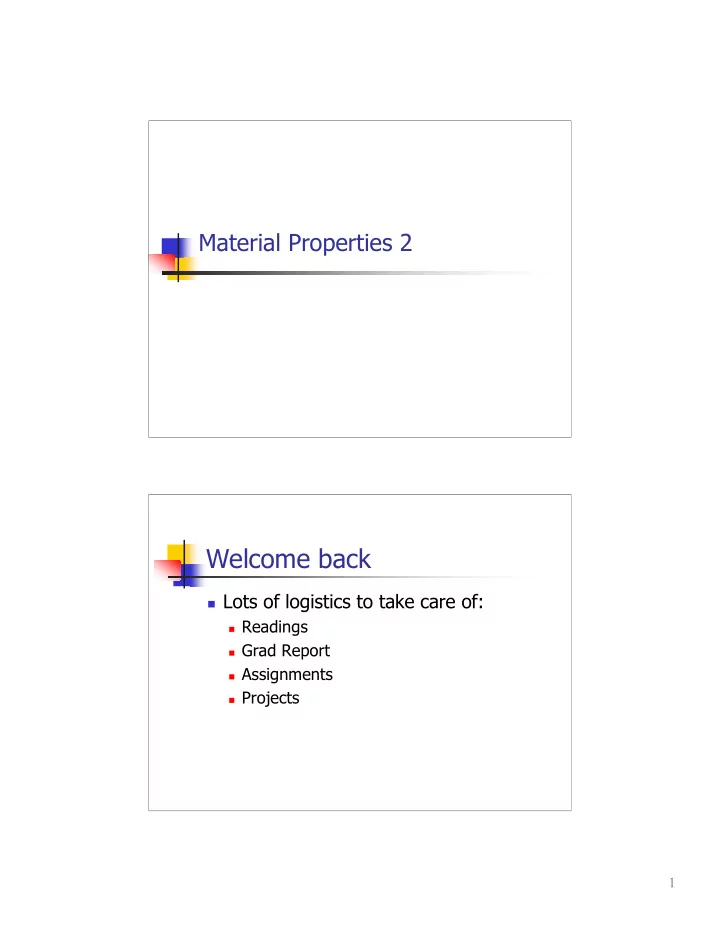

Material Properties 2 Welcome back Lots of logistics to take care of: Readings Grad Report Assignments Projects 1
Readings All readings up to week 3 graded Comments/grades on mycourses Remember to place this weeks in the dropbox. Grad Report Topic due tonight. Please place short description in dropbox. 2
Projects Proposals Proposal due before break (please get yours in if not submitted) Feedback on proposals -- mycourses Web sites please. 23 projects (4-5 more expected) Projects Presentations: Dates: Week 10: Mon, Feb 18 Week 10: Wed, Feb 20 Finals Week / Week 11: Mon, Feb 25 WE WILL NEED AN EXTRA DAY Week 11 or Week 9? 15 minutes / presentation Schedule on Web by next class Please send me choice of time/day 3
Assignments Checkpoint 1 - Setting the scene All graded Checkpoint 2 - Camera Due tonight. Checkpoint 3 - Basic shading To be given tonight. Plan for today Material Properties Bi-directional reflectance distribution functions (BRDFs) Advanced Illumination Models Beyond BRDFs Checkpoint 3 of the ray tracer Ray tracer help Questions 4
Computer Graphics as Virtual Photography real camera photo Photographic Photography: scene (captures processing print light) processing camera Computer 3D synthetic tone model Graphics: models image reproduction (focuses simulated lighting) Shading Computing the light that leaves a point Shading point - point under investigation Illumination model - function or algorithm used to describe the reflective characteristics of a given surface. Shading model – algorithm for using an illumination model to determine the color of a point on a surface. For efficiency’s sake, most illumination models are approximations. 5
BRDF Bi-directional Reflectance Function BRDF f ( , , , ) = � � � � r i i r r At a given point, gives relative reflected illumination in any direction with respect to incoming illumination coming from any direction; Note: The θ ’s are elevation, ϕ ’s are measured about the surface normal. The i ’s refer to the incident ray; the r ’s to the reflected ray. BRDF Geometry 6
BRDF Can return any positive value. Generally wavelength specific. BRDF = f ( , , , , ) � � � � � r i i r r Anisotropic Models Anisotropy Isotropic - surfaces reflect equally from any direction of view Anisotropic - reflection varies not only with angle of incidence, but also with the angle of the incident light w.r.t some viewing angle. Surfaces considered to possess an intrinsic grain Examples: satin, velvet, hair, brushed aluminum 7
Ansiotropic Models anisotropic (adj.) an · i · so · trop · ic 1. Physics. of unequal physical properties along different axes. http://www.neilblevins.com/cg_educatio n/aniso_ref/aniso_ref.htm Anisotropic Models Anisotropic reflection -- example Blevins Ward 8
Why does ansiotropic reflection occur? Occurs on objects with fine grain in a given direction. Blevins Anisotropic Models Ward Model [Ward92] Designed for both accuracy and ease of use Includes model for anisotropic reflection 9
Anisotropic Models Ward Model - Isotropic 2 2 − (tan γ ) / α ρ 1 e ρ = d + ρ ( • ) s 2 π πα θ δ 4 cos cos diffuse specular Anisotropic Model Ward Model ρ d - Diffuse reflectance coefficient (can vary with wavelength) ρ s - Specular reflectance coefficient (can vary with wavelength) α - Standard deviation of surface slope 10
Anisotropic Models Ward Model -- anisotropic 2 2 2 2 2 − (tan γ (cos φ / α + sin φ / α )) ρ 1 e x y d ρ = + ρ ( • ) s π cos θ cos δ 4 πα α x y diffuse specular Anisotropic Models Ward Model w/ ansiotropy α x - Standard deviation of surface slope in x-direction α y - Standard deviation of surface slope in y-direction 11
Ward’s Anisotropic Model Anisotropic Models Ward Model - example Photo Isotropic Anisotropic 12
Anisotropic Models Other anisotropic models (all based on physics) [Kajia85] [Poulin90] [He91] BRDF Simplifying Assumptions wrt the BRDF Light enters and leaves from the same point. Not necessarily true Subsurface scattering Skin, marble Light of a given wavelength will only reflect back light of that same wavelength Not necessarily true Light Interference Oily patches, peacock feathers 13
Subsurface Scattering Jensen, et al 2001 Subsurface Scattering Example: Skin Blevins,2001 14
bidirectional surface scattering distribution function (BSSDF) Relates outgoing reflectance in a given direction (at a given point) to the incoming luminance arriving at another point. bidirectional surface scattering distribution function (BSSDF) incoming BSSDF Outgoing luminance at x i luminance at x o in the direction in the direction of w i of w o When x o == x i the BSSDF is simply a BRDF 15
BSSDF -- Examples Using BSSDF Using BRDF Jensen, et al 2001 BSSDF -- Examples Using BSSDF Using BRDF Jensen, et al 2001 16
BSSDF -- Examples Using BSSDF Using BRDF Jensen, et al 2001 BSSDF Modeling Won Henrik Wann Jensen an academy award in 2004. Practical model described in [Jensen, et. al. 2001] 17
Using BSSRDF [Hao, 2004] Light transport functions BSSRDF (Bidirectional surface scattering reflectance distribution function) describes the relation between outgoing radiance and the incident flux, including the phenomena like subsurface scattering (SSS). BRDF (Bidirectional reflectance distribution function) is a simplified BSSRDF, assuming that light enters and leaves at the same point 18
Light Transport Functions Wikipedia Light transport functions BTDF (Bidirectional transmittance distribution function) is similar to BRDF but for the opposite side of the surface. (see the top image). BSDF (Bidirectional scattering distribution function) is the most general function. 19
Light transport functions Summary Advanced models of reflection Anisotropic Models BSSDF – subsurface scattering Complete transport functions. Adding to ray tracer. Break. 20
Recommend
More recommend